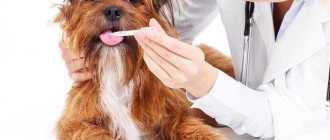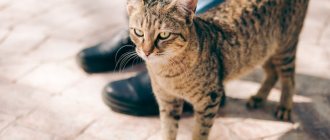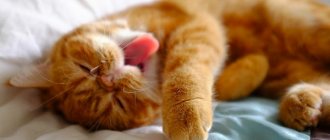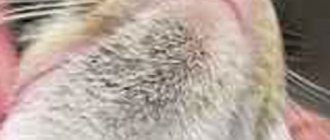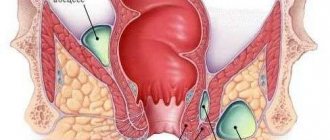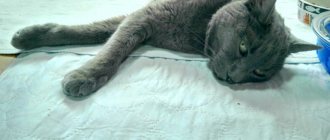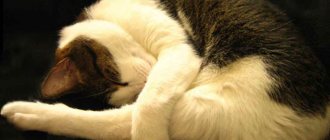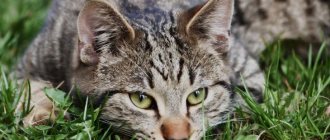3835Pavel
Feline hepatic lipidosis is a large amount of accumulated fat in the liver. It is a popular and dangerous liver disease in felines. Liver lipidosis in cats becomes noticeable when an excessive amount of triglycerides accumulates in hepatocytes in an amount of more than half. This can lead to interruptions in liver function and severe cholestasis.
The disease lipidosis occurs due to severe or constant starvation of cats. Without treatment, developing metabolic dysregulation often occurs, and subsequently death. The liver is considered the most important organ in the body and performs a large number of different functions, including metabolism, emulsification of fats and breakdown of red blood cells. Due to this, a malfunction of the liver, which occurs when lipids accumulate, can cause death in cats due to liver failure.
© shutterstock
There are two types of lipidosis::
- primary – this type appears in cats with obesity or anorexia. Without proper treatment, lipidosis is fatal.
- secondary – this type of disease appears as a complication after other diseases. Therefore, the cat needs intensive immediate treatment for lipidosis, along with the underlying disease.
The risk group includes cats and mature cats living in houses. Cats living with humans are predisposed to becoming overweight due to a sedentary life and due to improper feeding. Cats are carnivorous animals, members of the cat family. In the wild, they can hunt and lead an active life, and due to this, reduce the accumulation of excess fat throughout the body to zero. The owner needs to closely monitor the pet so as not to miss the symptoms of liver lipidosis in cats.
The cat's body is not able to convert a large amount of accumulated fat deposits, because of this, the fat that appears in the liver is poorly processed. This creates the prerequisites for changes in lipid metabolism, the accumulation of fat in the liver and the formation of its dysfunction, and as a result, liver lipidosis syndrome may appear in cats.
© shutterstock
What is lipidosis?
Not all people have a medical education, so they do not understand professional terms. Indeed, they are very complex, so we will give a simplified formulation of the definition of this pathology.
In animals suffering from lipidosis, the liver looks like a piece of lard. Why was this comparison used? The fact is that it describes the process as accurately as possible. In a pathologically altered liver, tissue degeneration occurs and fat accumulates. Over time, she cannot cope with functions, which leads to serious consequences. And for a cat this can be simply deadly.
Etiology of hepatic lipidosis in cats
In some cases, lipidosis is a secondary disease, although most cases are idiopathic. The most common primary lipidosis-causing diseases identified are pancreatitis, inflammatory bowel disease, and cholangiohepatitis.
The etiology of idiopathic feline hepatic lipidosis is unknown. Proposed theories are based on the participation of the liver in triglyceride metabolism. Triglycerides accumulate in the liver when the rate of synthesis exceeds the rate of removal.
Triglycerides are synthesized in the liver from fatty acids, the latter entering the systemic circulation during digestion. Once in the hepatocyte, fatty acids are synthesized to triglycerides and phospholipids or oxidized in the liver. Triglycerides are released from hepatocytes mainly as lipoproteins (VLDL).
When the liver's ability to excrete or oxidize triglycerides exceeds its triglyceride supply, triglycerides accumulate in hepatocytes. Therefore, the accumulation of lipids in the liver can lead to excessive synthesis of triglycerides in the liver and impaired fatty acid oxidation in hepatocytes, impaired transport of fatty acids from the liver to VLDL (Armstrong PJ, Blanchard G., 2009, p.
602), changes in nutritional or hormonal status, toxic effects on hepatocellular functions that negatively affect triglyceride metabolism. In addition, excessive triglyceride storage damages the hepatocyte, excessive triglyceride storage in the liver can disrupt cellular metabolism, and it can also affect other cell functions.
It is unknown how these mechanisms are involved in the pathogenesis of hepatic lipidosis in cats. Anorexia in previously obese cats.
An important feature of this disorder and can initiate fatty deposits in the liver (Valtolina C., Vaandrager AB, Favier RP et al., 2021, p. 231). During fasting, free fatty acids increase due to release from adipose tissue. Obesity is likely a predisposing factor in this process (Armstrong PJ, Blanchard G., 2009, p. 600).
There is excessive mobilization of fatty acids, which are subsequently not completely metabolized by the liver, leading to accumulation within hepatocytes. Some cats have a systemic disorder that causes anorexia and co-occurs with hepatic lipidosis, although in most cases no underlying disorder is identified.
It is not known what metabolic or hepatocellular abnormalities interfere with the removal of triglycerides from the liver, although some metabolic and ultrastructural abnormalities have been identified. In ultrastructural studies, cats with hepatic lipidosis had hepatocellular organelles and displaced nuclei toward the cell periphery, resulting in compression of the lumen of the bile canaliculi.
We suggest you read: Can rabbits be given milk?
This contributed to the development of cholestasis and bile acid retention. There is also a unique anomaly in that there is a relative shortage of peroxisomes. These organelles play an important role in preprocessing long-chain fatty acids before transporting them for mitochondrial oxidation.
Peroxisomes play an important role in mitochondrial dysfunction. Unlike mitochondria (which depend on carnitine), peroxisomal oxidation and transport of fatty acids are not dependent on carnitine. Peroxisomes are also involved in the synthesis of bile acids, and subsequent peroxisome dysfunction leads to bile stagnation in cats with hepatic lipidosis.
There is also speculation that there is a relative deficiency of carnitine leading to hepatocellular accumulation of triglycerides in cats with hepatic lipidosis. Plasma, urine, and liver tissue carnitine levels have been found to be normal (or elevated) in cats with hepatic lipidosis (Valtolina C., Vaandrager AB, Favier RP et al., 2021, p. 231).
However, it is possible that carnitine may not be sufficient for the amount and rate of mitochondrial oxidation and utilization of acetyl-CoA accumulation. In addition, urinary concentrations of short-chain acylcarnitines increase in cats with hepatic lipidosis, thereby reflecting increased production or removal of carnitine from the liver.
Orotic acid is a toxin that can cause liver failure, lipidosis in other species with impairment of phospholipid synthesis and VLDL transport from the liver.
Arginine deficiency (seen in cats with lipidosis) can lead to orotic acid accumulation because arginine is required for the normal urea cycle. Disorders of the urea cycle are associated with the production of orotic acid precursors. However, attempts to induce hepatic lipidosis in cats by administering orotic acid have been unsuccessful, and uric orotic acid concentrations have been found to be normal in cats with hepatic lipidosis.
Cyanocobalamin (vitamin B12) deficiency has also been suggested to be associated with hepatic lipidosis.
In one study, vitamin B12 deficiency was not documented in 96 cats with hepatic lipidosis. In this series, testing of plasma and urine for the presence of unusual fatty acids, reflecting site-specific defects in mitochondrial oxidative function, did not reveal any unique fragments, indicating that there was no obvious defect in a specific mitochondrial enzyme.
Forms
In medicine, this disease is divided into two forms. Both of them are considered independent:
- The first form of liver lipidosis in cats has characteristic symptoms. It manifests itself as a sharp decrease in weight, up to anorexia. This is especially noticeable in obese animals. If treatment is not started in time, there is a high probability of death.
- The second form of pathology is considered a consequence of other diseases. It can occur in cats suffering from diabetes, pancreatitis, as well as in those individuals who suffer from dysfunction of the genitourinary system or heart disease. In this case, treatment will be difficult, since it is necessary to fight not only lipidosis, but also the underlying disease.
Typical clinical signs of hepatic lipidosis in cats
As mentioned earlier, most cats with hepatic lipidosis are obese. There is usually a period of anorexia, which is accompanied by signs typical of liver failure. In some cases, a known illness, a stressful event (eg landing, travel) or a change in diet can lead to the initial stages of anorexia (Agnew W., Korman R., 2014, p. 755).
However, in most cases the underlying cause is unknown. When hepatic lipidosis occurs, clinical signs include lack of appetite, weight loss, vomiting, and jaundice. The physical examination result reveals (Table No. 3) obesity with signs of wasting of the spinal muscles, jaundice, and hepatomegaly is also possible.
It should be noted that among researchers there is an opinion that the clinical syndrome of jaundice manifests itself when the level of total bilirubin exceeds 25.0 (Agnew W., Korman R., 2014, p. 751), 35.0 (Kuzi S., Segev G., Kedar S., Yas E., Aroch I., 2017, p. 512) or 50.0 µmol/l (Armstrong PJ, Blanchard G., 2009, p. 600).
- Obesity
- Anorexia
- Weight loss
- Vomiting/diarrhea
- Jaundice
- Hepatomegaly
- Hepatic encephalopathy: depression, lethargy, agitation, ptyalism, compulsive disorders (rare: seizures or coma)
- Hemorrhagic diathesis (rarely observed, but in severe form: involves necrosis of a significant amount of liver tissue)
Causes
The reasons that can trigger the development of liver lipidosis in a cat are most often other diseases that lead to impaired functioning of the organ. These veterinarians include intoxication and oncology. It is also possible that the disease may develop in individuals infected with parasites.
Recently, the list of diseases has expanded. Now it includes pathologies of the kidneys, thyroid gland, heart, as well as disorders in the respiratory and genitourinary systems.
Unfortunately, according to statistics, doctors in 50% of cases cannot determine the exact cause. Then the animal is diagnosed with “idiopathic lipidosis.” However, most scientists have come to the conclusion that the most common factors in the development of the disease are autoimmune pathologies and obesity.
Differential diagnosis of liver lipidosis in cats
Primary liver disease - cholangitis/cholangiohepatitis, cholestasis, extrahepatic occlusion of the bile ducts and neoplasia, these are the most important differential diagnoses; differentiated by abdominal ultrasound, liver aspiration, and finally by liver biopsy. Congenital anomaly of the portosystemic circulation – rarely confused; differentiated by ultrasound or colorectal scintigraphy.
Hepatic toxoplasmosis or feline viral peritonitis is differentiated by liver biopsy. Pancreatitis – abdominal ultrasound, serum tests (increased trypsin-like immunoactive substances, elevated amylase, lipase; amylase and lipase are unreliable indicators) and/or direct imaging or biopsy.
Poisoning – suspected based on survey data (administration of oral forms of diazepam or acetaminophen (paracetamol)). Hyperthyroidism – based on the level of serum thyroid hormones.
Who is at risk?
Liver lipidosis in cats, the symptoms and treatment of which will be described below, is most likely to appear if the animal is overweight. These are the individuals at risk. Nervous disorders can aggravate the situation, especially if the animal is in a state of constant stress. And for this it is not necessary to scold the cat. This condition can occur if, for example, you change your usual habitat or brand of food. Hazardous factors include:
- infections;
- change of owner;
- the birth of a child in the family and much more.
Main symptoms
Various liver diseases in cats can be quite difficult to diagnose. The problem is that they occur without clear signs. However, if the animal is at risk, then the owner needs to closely monitor it.
Pay special attention to weight. The first and main symptom is its decrease without obvious reasons. A little later, the animal loses its appetite, sometimes even completely. And from this anorexia develops. This condition is caused by the liver being unable to perform its functions.
What does fatty liver mean?
The liver is the human body's filter from toxins.
It breaks down fats and helps in their distribution and absorption by body cells. It converts the glycogens obtained as a result of this process into glucose and replenishes the cells with energy.
Hematopoiesis of the organ consists of the synthesis of the main blood proteins. It accumulates a supply of vitamins, microelements and other compounds necessary for the functioning of the body. It also synthesizes proteins and enzymes for the normal functioning of the whole body.
Therefore, any changes in the functioning of an organ lead to a malfunction of all organs and systems. So, when metabolism is disrupted, for certain reasons, simple fats begin to intensively enter its cells. He does not have time to process and distribute them.
As a result, liver cells degenerate into fat cells, which do not perform their functions.
A malfunction occurs in the body and symptoms of fatty liver appear.
This disease is also called:
Timely recognition of the disease and its treatment can restore normal liver function.
Additional symptoms
If there are not so many main symptoms of liver lipidosis in cats, then there are more than enough additional ones. They appear after some time. So, let's look at how the animal's condition changes.
- Lethargy appears, the animal refuses to play.
- The shade of the skin and mucous membranes changes to yellow.
- Cats cannot control their thirst, so they often vomit.
- Nausea, loose stools, indigestion.
- Change in urine color to darker.
- Profuse salivation.
- A sharp putrid odor emanates from the mouth.
- Amyotrophy.
Every owner should know that if the listed signs appear, then they urgently need to contact the clinic.
Ultrasonographic findings in hepatic lipidosis in cats
Ultrasonographic findings are almost always abnormal in feline lipidosis. Changes typically include a general increased echogenicity of the liver parenchyma compared with the falciform fat. This parenchymal change occurs in almost 100% of cases in cats with lipidosis. However, increased echogenicity of the liver parenchyma occurs in other diseases, making this change nonspecific for hepatic lipidosis.
In addition, visualizing the boundaries of the liver vessels becomes quite difficult. Other underlying disorders, such as pancreatitis, may also be detected by ultrasound.
Fine needle aspiration of liver tissue confirming hepatocellular vacuolation; more than 50% of hepatocytes should contain transparent cytosolic vacuoles.
Microscopy – pronounced diffuse vacuolization of hepatocytes; several large (macrovesicular) or many small (microvesicular) vacuoles; content of vacuoles with neutral fats (triglycerides).
Symptoms in the final stages
Above was a description of the main symptoms of liver lipidosis in cats. Now let's look at how this pathology manifests itself in the final stages.
Serious changes occur in the animal's body. Blood loses its ability to clot. The disorder is caused by hepatic encephalopathy. In this condition, the cat must be hospitalized immediately, since there is already a direct threat to its life. The faster the diagnosis is made, the greater the chance of a positive prognosis. Unlike other organs, the liver is capable of regenerating. The main thing is that it is not too late.
Signs
Due to the accumulation of fat in cells in the animal’s body, toxic metabolic products accumulate, as a result of which digestive function, bile formation are disrupted, and metabolism also occurs incorrectly.
Characteristic signs of the disease are:
- refusal to eat for 3 or more days;
- weight loss;
- dehydration;
- severe drooling;
- yellowing of the skin, mucous membranes and sclera of the eyes.
The animal begins to vomit, diarrhea or constipation appears. The liver increases in size, but the animal does not experience discomfort when palpated. There are also nervous symptoms in the form of numbness, convulsions, loss of strength and depression.
Any symptom is dangerous to the animal’s health and should be shown to a veterinarian as soon as possible. In half of the animals, in addition to the indicated signs, coagulopathy develops, that is, a blood clotting disorder, and spontaneous bleeding may occur.
Diagnostics
There are many ways to diagnose liver lipidosis in a cat, but all of them are carried out only in a veterinary clinic. This diagnosis cannot be made visually; an examination is necessary. It includes:
- Blood chemistry. The laboratory checks the level of bilirubin, as well as enzymes and alkaline phosphatase.
- Ultrasound. The size of the liver is determined - whether it is enlarged.
- Analysis of urine. Urea contains high levels of bilirubin.
- Biopsy. Rarely prescribed. The material is collected under general anesthesia. It is considered the most accurate diagnostic method.
- General blood analysis. The condition of blood cells is checked for changes in size and shape.
Methods for diagnosing liver lipidosis in cats
Laboratory and X-ray studies.
Blood test findings reflect severe hepatocellular dysfunction and cholestasis with significant increases in hepatocellular and biliary enzymes and bilirubin (Martino-Costa AL, Malhão F., Lopes C., Dias-Pereira P., 2021, p. 75). A sign of hepatic lipidosis in cats is a very high level of ALP with a disproportionately low concentration of gammaglutamyltransferase (GGT) (Armstrong PJ, Blanchard G., 2009, p. 600).
Coagulation disorders are also common, occurring in almost 50% of cases. However, bleeding (including from liver biopsy sites) is quite rare.
We suggest you read: How to wash a cat - tips for owners
Hypokalemia is present in 25%-30% of affected cats, which also carries a negative prognostic factor. Hypophosphatemia is present in 10%-15% of cats with lipidosis. Oral nutrition may further decrease serum phosphorus concentrations, leading to clinical manifestations of hemolytic anemia.
X-rays usually reveal a normal liver size or hepatomegaly.
Treatment
Treatment of hepatic lipidosis in cats is best started in the early stages. In this case, there is a greater chance of saving the animal. But more often than not, owners bring their pets to the doctor too late. If the liver is already completely damaged, then it will not be possible to get rid of the disease. But don't give up. In this case, the specialist will prescribe treatment that will prolong the animal’s life and relieve symptoms.
It is important to remember that therapy must be comprehensive. In addition to medications, you need to choose the right diet. In a word, stick to your diet. For a sick cat, choose one that completely excludes protein products. If the pet refuses to eat, the owner will have to transfer it to artificial feeding. You also need to be prepared for such a development of events.
Dietary restrictions for fatty liver disease
The best results in the initial stage of the disease are achieved by diet, but only as prescribed by the attending physician. Medicine recommends that you absolutely abstain from any alcohol first.
Prohibited:
- semi-finished products;
- canned fish and meat;
- smoked meats;
- roast;
- salty;
- fat;
- spicy;
- meat and fish broths.
Doctors also tell you to forget about:
- radishes;
- radish;
- mushrooms;
- legumes;
- tomatoes;
- fatty dairy products.
Diet in treatment involves the use of:
- lean meat and fish;
- dishes that are steamed or boiled;
- low-fat dairy products;
- baked vegetables.
Allowed dishes from:
- rice;
- manna;
- oat;
- buckwheat.
You can eat one egg per day and only boiled one.
By following all the doctor’s instructions, you can achieve a complete recovery and restore the functions of the organ.
Stages of therapeutic therapy
Owners need to prepare for the fact that the fight against liver lipidosis in cats will be long. What treatment may be needed? It is divided into stages:
- Over the course of one to two months, the animal is given microelements intravenously. This will strengthen the immune system and reduce the risk of infectious diseases.
- If the pet refuses to eat, the clinic will install a special tube into the esophagus. This is only possible if his general condition is satisfactory. Such feeding better saturates the body with useful elements than injections.
- Be sure to instill glucose and Ringer's solutions. These drugs reduce intoxication and also restore water balance.
- Taking multivitamin complexes. They are prescribed only by a doctor. Due to the fact that the organ is no longer able to fully perform its functions, the body must be saturated with nutrients artificially.
- In order to prevent gastrointestinal diseases from developing, special medications must be given to the animal as a preventive measure. For example, "Neomycin", "Zantac".
- Immunomodulators are prescribed to strengthen the body.
- If lipidosis is infectious or inflammatory, then the animal must take broad-spectrum antibiotics.
Owners are advised to pay attention to the fact that appetite stimulants only help when the pet itself shows interest in food. Otherwise, they will not only be ineffective, but even harmful.
Veterinary clinic of Dr. Shubin
Description
Feline liver lipidosis is excessive deposition of fat (triglycerides) in the vacuoles of liver cells, which significantly impairs the functioning of the organ and can lead to the development of organ failure.
The exact causes of feline liver lipidosis remain unclear, so it is often referred to as idiopathic (a term that defines the uncertainty of the causes of development). The main trigger for the development of liver lipidosis in cats is the animal’s hunger; it can develop for one reason or another. To cover energy needs, the body begins to actively use body fat, but if there is insufficient protein intake from food, the liver cannot cope with its processing and fat, in significant quantities, accumulates in the cells. The accumulation (accumulation) of fat in the liver during lipidosis of cats significantly worsens its functions, this negatively affects the general condition of the animal, contributes to further refusal of food and thereby closes the vicious circle of the disease.
It should be remembered that a cat is an animal that tolerates hunger very poorly, and, in some cases, the reasons for eating are quite minor and resolve on their own, but the consequences have to be treated (often in the form of feline liver lipidosis).
Feline liver lipidosis is the most common lesion of the liver parenchyma. The disease has a number of synonyms, such as: feline idiopathic liver lipidosis, feline liver steatosis; fatty liver syndrome.
Causes
As mentioned above, the exact causes of the development of liver lipidosis in cats have not been determined and the main trigger is the animal’s hunger. Quite arbitrarily, feline liver lipidosis is divided into primary and secondary, depending on the reasons leading to the cessation of food.
Primary feline liver lipidosis or idiopathic lipidosis develops against the background of various stressful influences, leading to a short-term lack of appetite. Examples of such impacts include disturbances such as: upper respiratory tract infection, mating, introduction of a new animal into the population, change in diet. The starting mechanisms of idiopathic liver lipidosis are not always determined. Be that as it may, against the background of fasting, the body accumulates excess amounts of fat in the liver cells, which leads to dysfunction of the organ and its failure, which further disrupts appetite and leads to the formation of a vicious circle (lack of appetite - lipidosis - worsening appetite - worsening lipidosis ).
Secondary lipidosis of the liver of cats develops against the background of a number of other diseases that lead to refusal to eat. In this case, the development of lipidosis is provoked by other pathologies, examples of which include such abnormalities as: renal failure, hyperfunction of the thyroid gland (hyperthyroidism), inflammation of the pancreas (pancreatitis), diseases of the small intestine, various neoplasms. As in the case of primary lipidosis, a vicious circle develops (see above). Resolution of the primary diseases may be accompanied by resolution of the liver problems, and the cat with lipidosis begins to eat again and recovers. And in some cases, eliminating the primary problems does not lead to the animal’s recovery, and lipidosis of the cat’s liver has to be treated.
Clinical signs
In most cats with hepatic lipidosis, the medical history usually reveals some stressful life event (eg introducing a new pet into the home, sudden changes in diet) or an illness leading to loss of appetite. The initial event is not always established. Secondary hepatic lipidosis, along with obese animals, can affect cats of normal weight or in a state of emaciation, and signs of the disease are often hidden by an underlying medical condition.
If at the beginning of the development of lipidosis there are uncharacteristic signs (eg weight loss, dehydration, drooling, vomiting), then as the disease progresses, jaundice may develop (more often visible on the skin of the ears and mucous membranes of the oral cavity), severe exhaustion is noted, and signs of brain damage are likely . (eg depression, head pressing, dizziness). Rare signs of feline liver lipidosis include symptoms such as diarrhea or constipation. When palpating the abdominal cavity at a veterinary appointment, an increase in the size of the liver is usually easily determined. Signs of liver lipidosis may come to the fore, or be accompanied by signs of a primary disease that caused the refusal to eat food.
Diagnostics
A suspicion of feline liver lipidosis arises from a veterinarian when the animal has been starving for a long time. A general blood test reveals nonspecific signs (eg moderate anemia, stress leukogram). A biochemical blood test reveals an increase in the level of bilirubin and a number of liver enzymes. With increasing liver failure against the background of feline liver lipidosis, biochemistry reveals signs of organ failure (eg decreased albumin protein, decreased glucose levels, decreased urea levels), this can serve as an unfavorable prognostic sign.
Abdominal radiography (X-ray) usually reveals an enlarged liver, but the size of the organ may remain within normal limits in cases of lipidosis. An ultrasound examination of the liver reveals a diffuse increase in the echogenicity of the liver parenchyma, but these changes cannot be considered strictly characteristic of lipidosis (various variations are likely).
The diagnosis of feline liver lipidosis is established by performing a fine-needle biopsy with material collection and subsequent cytological examination (these manipulations suggest a diagnosis with a high degree of probability). The final diagnosis (100%) requires surgical removal of a piece of liver followed by pathological examination by an experienced specialist (extremely rarely used in global veterinary practice). The bottom line is that neither fine-needle biopsy, followed by cytological examination, nor surgical biopsy are performed in our veterinary clinic.
Also, with lipidosis of the liver of cats, an attempt is made to identify the primary disease leading to refusal to eat. In most cases, treatment for lipidosis begins when its presence is suspected, without waiting for the final results of diagnostic tests.
When diagnosing feline liver lipidosis, diseases that give similar clinical manifestations are also taken into account: feline cholangiohepatitis, liver neoplasms (usually lymphoma), inflammatory bowel diseases, inflammation of the pancreas.
Treatment
The basis for the treatment of feline liver lipidosis is enteral feeding, which provides the animal with the components necessary for recovery. This type of feeding is carried out only when various types of feeding tubes are installed. For entral feeding, preference is given to installing an esophageal feeding tube; in extreme cases, tubes can be inserted into the esophagus through the nose or through the skin directly into the stomach.
Forced feeding through the mouth and the use of various appetite stimulants for liver lipidosis are not sufficient for complete recovery. Against the background of forced feeding through the mouth, the animal can quickly (within 2 days) develop an aversion to a certain type of food, which makes subsequent feeding through a tube difficult. Forced feeding through the mouth leads to stress in the animal, which can worsen the course of lipidosis. And lastly, forced or forced feeding through the mouth is simply not able to provide the animal with the necessary amount of calories, and in this case the nutrition will be insufficient.
With enteral feeding, the animal is provided with sufficient calories and receives readily available proteins, fats and carbohydrates. The supply of nutrients gradually inhibits the accumulation of fat in liver cells and leads to the reversal of the disease. The nature of feeding should be consulted directly with the staff of the veterinary clinic. In case of successful lipidosis, the liver feeding tube is removed 4-7 days after the start of independent food intake; the tube should not be removed too early (it does not interfere with independent food intake).
At the initial stage of treatment, an animal with liver lipidosis may require the administration of antiemetics; in our veterinary clinic, the drug “Serenia” is widely used, it is administered subcutaneously once a day.
Forecasts
Feline liver lipidosis is characterized by a fairly high mortality rate. A number of authors estimate that the mortality rate for feline liver lipidosis can reach 40% (60% is a successful outcome). Tube feeding can take quite a long time, some animals require nutritional support for a fairly long period (2-3 months), many animals with liver lipidosis begin to eat on their own within 2-4 weeks from the start of feeding.
Veterinary clinic of Dr. Shubin, Balakovo
Forecast
Unfortunately, if a cat has been diagnosed with liver lipidosis, veterinarians cannot give accurate predictions. The disease is very serious; complete recovery of the pet is rare. The statistics are disappointing - every third animal dies.
But owners should not get upset ahead of time and give up. If the pathology was diagnosed in the early stages and the doctor’s instructions were strictly followed, then there is every chance that the cat will live a long life. However, to do this you will have to monitor his diet.
The prognosis is influenced not only by timely treatment, but also by other factors. These include age and general condition. Of course, young individuals have a better chance of coping with this insidious disease. But among adults the mortality rate is high. This is because they are already in poor health. As a rule, the pathology is complicated by concomitant diseases.
Diet
What to feed a sick animal? First of all, doctors recommend foods high in protein. This helps reduce the amount of lipids accumulated in the liver.
According to statistics, limiting protein intake is necessary for no more than 5 percent of sick animals, that is, only if encephalopathy is detected in them.
Carbohydrates are much less tolerated by cats and, in addition, they can provoke:
- diarrhea;
- spasmodic pain;
- increase in sugar;
- intestinal problems.
Prevention
In order to avoid the development of liver lipidosis in a cat, you must first adhere to proper feeding. Under no circumstances should overeating be allowed. The diet should be rich in minerals, vitamins and other beneficial substances.
It is advisable for your pet to eat vegetables regularly, you can even give fruits. They contain fiber, which improves digestion. Also, we must not forget about deworming and vaccination. Of course, these measures cannot give a 100% guarantee, but still you should not neglect such recommendations.
Unfortunately, no doctor can prescribe a specific preventive regimen. The problem is that not all the causes that provoke the development of lipidosis are known.


